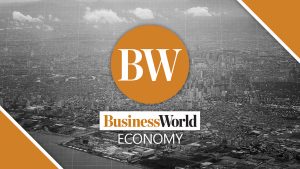The economy under Marcos 2.0

PHILIPPINE STAR/ KRIZ JOHN ROSALES
By Romeo L. Bernardo and Marie Christine G. Tang
WE ARE PLEASED to share excerpts from our July 5 special report to GlobalSource Partners subscribers. GSP (globalsourcepartners.com) is a New York-based network of independent analysts in emerging market countries. Its subscribers are mostly global banks and fund managers.
Ferdinand R. Marcos, Jr., took his oath of office as the 17th President of the Philippines on June 30. He is starting his six-year term at a particularly inauspicious time. Two years of battling the pandemic has left the economy weakened, with output barely back to 2019 levels and government limited in macro policy headroom due to rising inflation, hefty budget deficits alongside higher public debt, and a ballooning of the current account deficit. The economy is also facing external headwinds due to a slowing global economy, a gloomy outlook for energy and food markets as well as continuing supply chain bottlenecks that are pushing up global inflation, and tighter financial market conditions as advanced economies try to rein in soaring inflation. Downside risks remain elevated due to increased food and energy insecurity, rising risk of recession in the US, debt overhang and possible defaults in emerging markets.
CONTINUITY AND CHANGEIn two major respects, Marcos 2.0 represents a continuation of the Duterte administration: a seamless transition at the macroeconomic policy level, with economic managers drawn from the last two administrations; and a commitment to sustaining investments in infrastructure at 5% of GDP, with old hands manning infrastructure agencies and PPP experts brought in key departments.
Notwithstanding broad policy continuity in these two areas, we expect a major change in working relationships. Previously, Finance Secretary Carlos G. Dominguez III was the recognized team leader given his unique friendship with the former President dating back to primary school. In comparison, we expect collaboration within the Marcos team to be more collegial, reflecting the members’ decades-long personal relationships. Too, although Messrs. Benjamin Diokno and Felipe Medalla have the more high-profile jobs as far as financial markets are concerned, we expect Mr. Arsenio Balisacan to have greater influence in steering the economy in new directions, including possibly agricultural policy.
In two notable areas, Marcos 2.0 is gearing up for change: agriculture and education. The clearest signal is that the President and the Vice-President, Sara Duterte-Carpio, are taking over those portfolios. Both sectors suffer from decades of government underinvestment (and especially in agriculture, poor governance) and will take years to reform to improve their developmental impacts. Both sectors are now grappling with rising risks, the former a looming food crisis, the latter in relation to the two-year suspension of in-person schooling.
Based on the appointments, two other areas where more balanced policies, important for the economy, can be expected moving forward are in foreign affairs and labor and employment.
THE NEXT 365 DAYSThe overriding goal of the economic managers is to sustain job creation to drive economic growth of 6-7% over the term of the administration. They need to do this without benefit of the expansive macro policy room that their predecessors enjoyed at the starting line. Thus, more than the previous administration, they need to gain investor confidence quickly to unlock private capital.
One may view the many challenges they now face as messaging opportunities, especially for foreign investors, to help dispel doubts about the new regime and assure them of a level playing field. It is also an opportunity for the President to show leadership, how he resolves policy trade-offs and handles conflicting interests. Five major areas where concrete action plans are needed to match the rhetoric are worth highlighting:
1. Macroeconomic stability. The goals are twofold. More immediate is to signal and demonstrate ability to bring headline inflation back to target (2-4%) as early in 2023 as possible to minimize the risk of de-anchoring inflation expectations. Aside from the conduct of monetary policy, non-monetary interventions to address supply shocks and bottlenecks are important. Second is to present markets with a credible fiscal consolidation plan to avoid a credit rating downgrade, especially as external balances deteriorate. We expect details of the plan to be unveiled when the President presents his legislative agenda in his State of the Nation Address.
2. Financing infrastructure and PPP. There are about 100 flagship infrastructure projects worth close to P5 trillion, both ongoing and under review, that the Duterte administration is leaving behind. There is no question that the new administration will continue to implement projects that have started. Rather, the question is how the government will finance the big-ticket projects going forward given budget constraints. Although development partners are a major funding source (about P2.7-trillion total), these projects require budget cover from the government that contractors tell us is not fully assured, based on the latest approved national budget.
The list also includes many PPP projects that could help to sustain infrastructure investments under much constrained fiscal conditions. Although this suggests that there is no lack of private sector interest, government initiatives to rebuild trust in these long-term contracts will be needed considering the previous administration’s antagonistic stance towards long-standing PPP contracts (e.g., Manila’s water concessions) as well as reticence in granting sovereign undertakings that have been common in awarded PPP contracts (e.g., certain material adverse government actions, international arbitration, automatic adjustments in user fees). A revisit of the midnight implementing rules and regulations (IRR) of the BOT law done by the last administration that was roundly criticized by business organizations, think tanks and potential investors is in the works.
3. A looming food “crisis” and agriculture sector reform. The President himself placed this on the people’s radar screens and, given the global food shortage and price spikes as well as his campaign promise of P20 rice, almost half of current market price of regular milled rice (P37), the question on many people’s minds is what his intentions are for rice. Although there have been worries that he will reverse reforms initiated by the Rice Tariffication Law, which allowed freer imports and helped keep the price of the grain stable, he has not talked directly about the issue since his election
In his inauguration speech, the President expressed a broad desire to achieve food sufficiency and reduce reliance on imports. But he also pointed to his father’s administration as the only one that delivered on food self-sufficiency, bringing to listeners’ minds the elder Mr. Marcos’ Masagana 99 program which, while contributing to rice self-sufficiency, proved unsustainable due to high fiscal costs, and as farmers defaulted massively on government’s directed credit programs.
4. The lingering health crisis and resuming face-to-face classes. Since the January Omicron surge, the country has avoided further surges in COVID-19 infections. Experts think that the disease has likely become endemic. However, removal of health protocols, including the basic masking policy, has been impeded by the low level of booster dose take-up, in large part due to local governments being preoccupied by the elections.
So far, the private sector is still not allowed on its own to procure the vaccines, which have only emergency use authorization, and the pharmaceutical companies themselves have no incentive to move away from the current system of wholesale public procurement. The failure to sustain vaccination momentum is hindering the education sector’s ability to return to in-person classes, with less than 15% of schools conducting face-to-face instruction.
5. Power supply. Here we wish to highlight investor concerns about the reliability and cost of power over the medium term. The most pressing issue is related to the Malampaya natural gas reserves. Five power plants that provide about a fourth of the main grid’s generation mix run on Malampaya gas. Not only will the take-or-pay contracts expire by 2024 but estimates of remaining gas reserves indicate that these will be depleted by 2027. The grid will require higher-cost replacement fuel to run these power plants.
Moreover, for the economy to grow at 6-7% over the medium term, some 600 MW of new power supply will be needed annually to meet demand. The new administration will need to balance the needs of energy security with calls for decarbonization.
The new administration’s ability to put out these fires will define its ability to pursue meaningful structural reforms over the medium term and gain investor and the public’s confidence. Considering rising external risks related to food and energy markets, tightening financial conditions and worsening global growth prospects, we think any policy misstep in any of the above could be costly for achieving the economic managers’ aim of sustaining economic growth at 6-7%, alongside job creation.
As it is, we think that just the pandemic has eroded the economy’s growth potential by at least a percentage point and that in the short term, its lingering effects will continue to sideline many service industries, while investors will continue to wait and see what the new administration can and will do.
Momentum in vaccination would have to be restored to help keep economic growth momentum going. In this regard, finding a permanent Health Secretary is quite pressing. In terms of maintaining economic growth, some of the areas we cited above require immediate solutions to avoid social unrest (e.g., securing food supplies and inputs to production at reasonable prices) and ensure continuing growth (e.g., reopening in-person schooling, infrastructure). Others are a matter of credibly committing to a realistic medium-term action plan with concrete targets (e.g., fiscal consolidation, power supply adequacy, agricultural reform) to help build investor confidence and allow the recently legislated foreign investment reforms to bear fruit.
In addressing urgent issues, government needs also to keep an eye not only on the fiscal costs but also the risks. Many applauded the President’s Day One veto of an enrolled bill to create a special economic zone and freeport around a PPP project on the ground that it posed substantial fiscal risks for government. The same people are now wondering whether they could expect such good sense to be applied consistently going forward.
Mr. Bernardo co-writes the Introspective column for BusinessWorld. He and Marie Christine G. Tang serve as GlobalSource Partners Philippine advisers.




